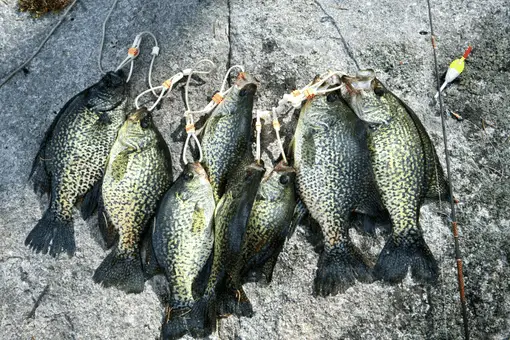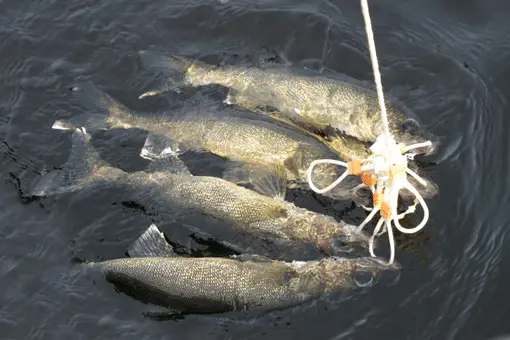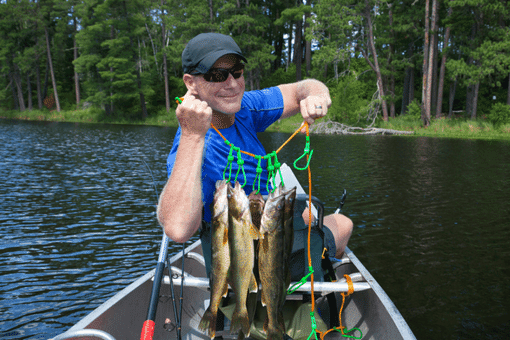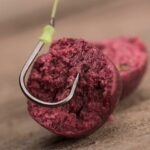Fish stringers are the most common and best way to keep your catch alive during long fishing trips. Using them is relatively simple, though many people are stringing their fish with a technique that may kill them faster.

Even some of the most experienced fishermen still string their fish with this popular approach, and while not technically incorrect, there’s a much more optimal way.
Keep reading to learn the best method of using a fish stringer and how you can keep your catch alive longer.
How To Use a Fish Stringer
To use a simple fish stringer, poke a hole in the soft tissue at the bottom of the fish’s mouth with the tip of the stringer. Pull the string all the way through until it reaches the metal ring on the end. Afterward, thread the tip of the stringer through the metal loop and pull until the fish is secured.
Of course, spring lock stringers are also pretty popular nowadays because they’re efficient and can hold a decent haul of fish. To use a clip stringer, unhook one of the clips, poke a hole in the bottom of the fish’s mouth, and then close the clip.
Many people like to run their stringers through the mouths and out the gills. Unfortunately, this is not the best way to string a fish, and should be avoided. First, it greatly restricts the fish’s movements and may cause them to die faster.
Furthermore, because it’s going through one of the fish’s vital organs, it can cause internal damage and kill the fish. Stringing the fish through the bottom of its mouth is the most surefire way to ensure your catch stays alive as long as possible.
What Is a Fish Stringer?
A fish stringer is a fishing tool that secures caught fish while allowing them to remain in their natural habitat. This is especially useful during long fishing trips where you want to keep the fish you catch alive for as long as possible.

There are four main types of fish stringers:
Paracord Fish Stringers
The most common type of fish stringer is the paracord fish stringer.
A paracord stringer has a needle-like piece of metal on one end, a lengthy amount of tough string, and a ring on the end. These aren’t hard to use and are among the cheapest stringers on the market.
They’re fantastic for beginners and experts alike who want a practical and affordable way of keeping their catches alive.
Spring Lock Stringers
Spring lock stringers are long pieces of string or rope with numerous spring lock clips along the side. They’re much more convenient than traditional paracord fish stringers and can typically hold more fish.
Spring lock clips are relatively easy to use. All you do is press down on the lock side, which causes the clip to open. From here, you can attach the fish and close the clasp. While holding a large haul of fish is efficient storage-wise, there’s a higher chance that some of them will die. In this case, it’s sometimes better to use single-fish paracord stringers.
Chain Stringers
Chain stringers are a type of spring lock stringer, but instead of a string, they’re made of chains. This type of stringer is excellent for stronger fish (fish such as bass, catfish, big game fish, etc.) and under harsh conditions but doesn’t perform as well otherwise.
They’re a lot heavier, so they end up weighing the fish down and can result in a catch’s untimely death. They can also be a bit clunkier to handle, though they don’t get tangled like paracord stringers.
Rope Stringers
Rope stringers are essentially the same as paracord fish stringers and spring lock stringers, except they’re made out of rope. They’re typically for more robust fish – similar to chain stringers – but don’t weigh the catch down as much.
There are some advantages of using a chain stringer over a rope stringer, though. While less effective at keeping fish alive, they are much sturdier than rope or string. They’ll last a lot longer and are way more reliable (especially since most chain stringers are made of steel and will probably never break).
How Do You Use a Fish Stringer on a Kayak?
Using a fish stringer on a kayak is self-explanatory. You thread the fish through whichever stringer you have as you normally would and keep them attached to the side of your boat. Making sure that they’re securely fastened to your Kayak is essential for ensuring that you don’t lose your stringer OR your catch.
Fish stringers are great for kayaks, especially when you want to catch and keep a lot of fish. Since kayaks are a more compact boat, you likely don’t have much space to work with. That means you probably don’t have a cooler, so your fish could start to go bad if you don’t keep them alive.
Why Use a Fish Stringer?
The primary purpose of a fish stringer is to keep the fish you catch alive. If you were to kill them on the spot or put them in a cooler, they’d start to rot unless you left your fishing spot immediately. Since most fishing trips last hours, or even the whole day, you’re probably going to want to have your fish stay alive until you’re ready to go.
Keeping your fish fresh isn’t only good for preventing harmful bacteria from growing; it’s also vital for making sure it tastes the best it possibly can. Once the fish dies, its body begins to go through a breakdown process of decay which may impact the flavor.
Keeping it alive with a stringer can help maintain taste without sacrificing precious fishing time.
Some people like to fill a cooler with water and put their fish in there, but there are two problems with this method; first, small spaces like a cooler will significantly restrict their movement. Less movement space means they’ll likely struggle more and run out of energy much faster.
The second issue is that they can run out of oxygen in a closed cooler. This is even more prominent when you add more fish to the equation, as the oxygen levels will deplete even faster. And once one fish dies, it releases chemicals in its body that contaminate the water and causes the other fish to follow suit.
So instead of leaving your fish in tiny spaces of stagnant water, you should probably stick to using a stringer.

How Long Can You Keep Fish on a Stringer?
You can typically keep a fish on a stringer for a few hours, but there isn’t a set amount of time. Depending on the species, some fish will begin to fight against the stringer causing them to injure themselves and die faster, while others will last the whole day.
Longer stringers give them more freedom to swim about, though if you have multiple fish on it, you’ll run into a similar issue.
Stringers aren’t a surefire way to keep all your fish alive 100% of the time, but they’re typically your best bet. This is even more true when you’re limited on space, such as on a kayak or other small boat.
Are Fish Stringers Bad for Fish?
So, are fish stringers bad for fish? Yes and no.
The purpose of a fish stringer is to keep fish alive so that they’re fresh when you decide to eat them. This reality means that while a stringer can harm them in multiple ways and even cause them to die, there is no merit in NOT using them. They’re technically “bad” for the fish’s wellbeing, but the whole point of using one in the first place is to kill and eat the fish.
From an ethical standpoint, yes, being attached to a stringer may cause the fish unnecessary stress. Is it better than being stuck in a small cooler with a tiny bit of water? Most certainly. Put bluntly; fish don’t experience pain the way humans do. Because of this, you can rest assured knowing your fish isn’t having a major panic attack until you’re ready to leave.
Of course, if you’re stringing them up to take a picture at the end of your trip with the intention of releasing them, then yes, a fish stringer is terrible for a fish.
Final Thoughts
Stringers are pretty much the best way to keep your fish fresh during long periods at the lake or when you’re traveling down the stream in a kayak. And with so many different types of stringers on the market, you won’t have any trouble finding one to accommodate your needs.
Do you catch a lot of fish at once? Try a spring lock stringer. Need one that’s cheap but works well? You can’t go wrong with the traditional paracord stringer.
When all is said and done, fish stringers are essential for any fisherman who wants to catch and cook their fish.
- Do You Need An Indicator For Nymph Fishing? - November 16, 2023
- Fishing Safety Tips For Families - September 25, 2023
- What Is The Best Time To Night Fish At A Lake? - September 18, 2023









